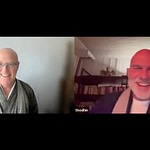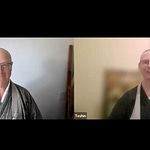Several of the teachers I’ve interviewed thus far here at Shake Out Your Sleeves have a lineage connection with one of the great Zen pioneers, Robert Aitken Roshi, including James Myōun Ford, Melissa Myozen Blacker, and Teshin Sweger. So I was delighted when Michael Kieran, the primary teacher at the Palolo Zen Center, long-time student of Robert Aitken Roshi and successor of Nelson Foster, agreed to talk.
I only met Aitken Roshi once, but I’ve read his books, and especially the classic The Gateless Barrier. My impression of Michael is that he’s a teacher with much the same subtle view, fine-tuned tone, and gentle intensity of his grand teacher. And, therefore, a powerful example of the transmission of Zen in the West.
Michael was also interviewed recently by Rick McDaniel. Read all about that here: Richard Bryan McDaniel: Zen Conversations and Profiles. Indeed, I built the interview questions around Rick’s interview. Michael told Rick:
“...The way of awakening which leaves you nowhere to stand and is only a way,
no parking allowed, that – to me – is what has to be preserved if Zen is going to stay alive.
And I think our tradition has a very interesting way of doing that in koan study,
which can certainly become formalized and dead. But it doesn’t need to.…
So that is a gift I’ve been given and that I want to give away.
I don’t want any of it to stay with me.”
So I ask Michael, “What makes what our tradition offers through koan work so interesting in terms of keeping the tradition alive?”
And “Can you say more about ‘formalized and dead’? In other words, how is it that koan work can go wrong?”
Check out his answers in the podcast.
And thanks again to Sam Kigen for their video editing support!
Comments and questions are welcome!
The kōan that we discuss is from Record of Going Easy, Case 6: Mǎzǔ’s White and Black:
舉
A monk asked Great Master Mǎzǔ, ”Apart from the four phrases and cutting off the hundred negations, I ask the Master, point straight to the meaning of [Bodhidharma] coming from the west.”
Master Mǎzǔ said, ”Today I am exhausted and can’t explain for you. Go ask Zhìzàng.”
The monk asked Zhìzàng. Zhìzàng said, ”Why not ask the Venerable?”
The monk said, ”The Venerable told me to come and ask.”
Zhìzàng said, ”Today I have a headache and can’t explain it to you. Go ask elder brother Huáihǎi.”
The monk asked elder brother Huáihǎi. Huáihǎi said, ”When I reach that point, I find that I don’t yet understand.”
The monk brought this up with great master Mǎzǔ.
Mǎzǔ said, ”Zhìzàng’s head is white, Hǎi’s head is black.”
“I’m exhausted, I have a headache, I don’t get it. What the heck is going on here?” A koan and commentary in less than 1000 words:
Coming soon
Mǎzǔ’s White and Black in Full: Record of Going Easy, Case 6: “When the four mountains appear to be pressing in, how can you escape?”
Over at Vine of Obstacles Zen
“How Much Zazen Should I Do?” With the snappy subtitle: “No offense intended, but from what we’ve seen, probably a lot more than you are now doing.” That’s if you identify as a Zen practitioner, of course. This post is open to all.










